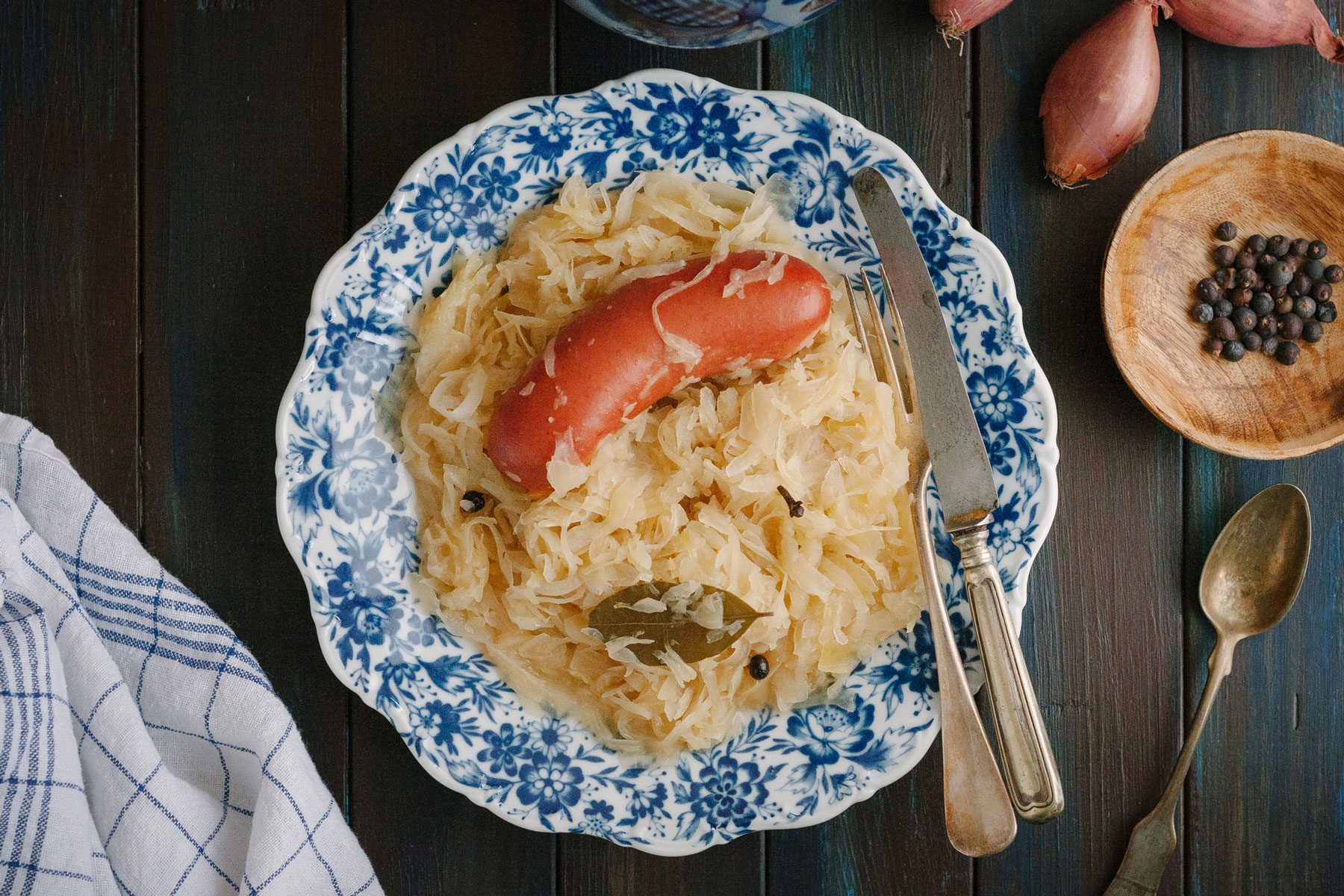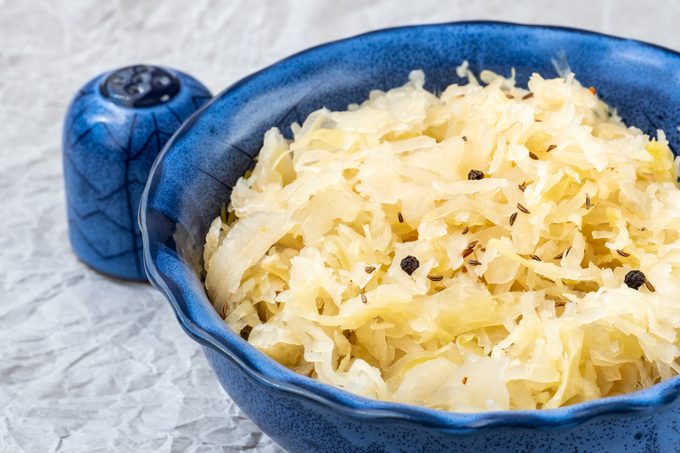Here's the real reason as to why people enjoy eating pork and sauerkraut on New Year's

Why Do People Eat Pork and Sauerkraut on New Year’s Day?

New Year’s is packed with traditions, and when it comes to food, few are as iconic—or as lucky—as pork and sauerkraut. This dynamic duo has been a staple on New Year’s tables for generations, but have you ever wondered why people eat pork and sauerkraut on New Year’s?
Where did this delicious New Year’s food tradition come from, and what makes it the perfect way to kick off the year? We went straight to the experts—culinary historian Linda Pelaccio and Drew Anderson, founder of Cleveland Kitchen—to dig into the flavorful history behind this festive pairing.
So, read on to learn why pork and sauerkraut are a match made in New Year’s heaven. We even share a mouthwatering recipe to bring some extra luck to your table!
Get Reader’s Digest’s Read Up newsletter for more holiday insights, humor, cleaning, travel, tech and fun facts all week long.
What is the origin of eating pork and sauerkraut on New Year’s?

The New Year’s tradition, and the now-classic food pairing, can trace its origins back to Germany. Germans and other pig-raising cultures have been eating these dishes for centuries, with immigrants bringing the tradition to the United States in the 17th and 18th centuries. People of Czech, Hungarian and Polish ancestry enjoy the food pairing as well. That’s why eating pork and sauerkraut on New Year’s is concentrated in areas with higher populations of these cultures, like the Midwest and the Pennsylvania Dutch country. There’s no grand deeper meaning for eating these two foods together, other than the fact that “rich, fatty and salty pork is the soulmate of tart and lean kraut,” as Serious Eats puts it. But as for the specific foods and their connection to New Year’s, there’s a lot more to it!
Why pork on New Year’s Day?
Eating pork on New Year’s Day isn’t only common because it’s delicious—it is also thought to be good luck. Having good luck is a popular New Year’s resolution, so it’s no wonder people eat pork and sauerkraut on New Year’s. The first reason for this goes back to the pig itself: In order to find food, a pig roots moving forward, according to Pelaccio. “It’s good to always go forward into the next year—you don’t want to go backward,” she tells Reader’s Digest. “For instance, we would not eat lobster for luck in the new year because lobsters walk backward.”
In addition, Pelaccio says that pork is considered good luck because it is so rich in fat, and the fat signifies prosperity. Some people eat pork on the first day of the year in the hopes it will bring a lucky and prosperous year.
Last, round foods are also thought to be good luck, Pelaccio explains, because the shape signifies coins and good fortune. Many traditional ways of preparing pork—including an Italian dish called cotechino, which is ground pork stuffed into a casing—are cut into round pieces when served.
Why sauerkraut on New Year’s?

Even though sauerkraut is served in strands, the cabbage it originates from is round, which, as Pelaccio mentioned, is a shape thought to bring good luck. So of course people want to ring in 2025 with food seen as positive. It’s also green, a color associated with financial prosperity. “Symbolically, as many shreds of cabbage from the kraut is the amount of wealth you’ll have in the new year,” says Anderson.
There are also logistical reasons we eat sauerkraut this time of year. According to Anderson, October and November are peak harvest times for cabbage in Germany and Eastern Europe, where sauerkraut is especially popular. At that point, the cabbage is chopped and put in barrels to begin the fermentation process.
“Usually around New Year’s [Day], fresh produce is scant, so these fermentation barrels are tapped and the good stuff begins to flow,” Anderson says. “The underlying health benefits of eating kraut also contribute to this tradition, as historically, fermented foods were a big source of vitamin C and nutrients when fresh produce wasn’t available.” In other words, people want to start the new year with a healthy meal. This makes eating pork and sauerkraut on New Year’s, especially when throwing a New Year’s party, even more appealing.
How do you make pork and sauerkraut for New Year’s?
Whipping up a delicious batch of pork and sauerkraut on New Year’s is easier than you might think—even for beginners! Thankfully, Taste of Home has a foolproof recipe that’s sure to impress. We’ve condensed it down for you below so you can get cooking in no time.
Ingredients
- Pork ribs
- Onion
- Canola oil
- Sauerkraut
- Unsweetened applesauce
- Brown sugar
- Caraway seeds, garlic powder and pepper
Directions
- Brown the pork ribs in canola with the onion until the ribs are browned and the onion is tender.
- Make the mixture with the remaining ingredients.
- Bake the pork and sauerkraut in a 350°F oven until the ribs are tender, or 1-1/2 to 2 hours.
Want to take your pork and sauerkraut up a notch? Try adding a few tasty twists: a dollop of mustard for a tangy kick, hearty potatoes for a comforting touch or chopped apples for sweetness and extra texture.
About the experts
|
Why trust us
At Reader’s Digest, we’re committed to producing high-quality content by writers with expertise and experience in their field in consultation with relevant, qualified experts. We rely on reputable primary sources, including government and professional organizations and academic institutions as well as our writers’ personal experiences where appropriate. For this piece on eating pork and sauerkraut on New Year’s, we spoke with Linda Pelaccio, a culinary historian and host of A Taste of the Past and Drew Anderson, the co-founder of Cleveland Kitchen. We verify all facts and data, back them with credible sourcing and revisit them over time to ensure they remain accurate and up to date. Read more about our team, our contributors and our editorial policies.
Sources:
- Linda Pelaccio, culinary historian and host of A Taste of the Past
- Drew Anderson, co-founder of Cleveland Kitchen
- Serious Eats: “The True Story of Traditional New Year’s Lucky Foods”
- Wildbrine: “Why you should eat sauerkraut on New Year’s Day”
- Times Union: “Sauerkraut on New Year’s a Pennsylvania tradition”























